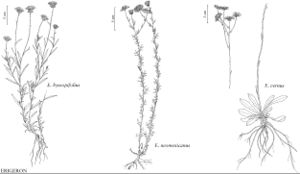Difference between revisions of "Erigeron hyssopifolius"
Fl. Bor.-Amer. 2: 123. 1803.
FNA>Volume Importer |
FNA>Volume Importer |
||
| Line 12: | Line 12: | ||
|name=Erigeron hyssopifolius var. anticostensis | |name=Erigeron hyssopifolius var. anticostensis | ||
|authority=Victorin & J. Rousseau | |authority=Victorin & J. Rousseau | ||
| + | |rank=variety | ||
}} {{Treatment/ID/Synonym | }} {{Treatment/ID/Synonym | ||
|name=Erigeron hyssopifolius var. villicaulis | |name=Erigeron hyssopifolius var. villicaulis | ||
|authority=Fernald | |authority=Fernald | ||
| + | |rank=variety | ||
}} | }} | ||
|hierarchy=Asteraceae;Asteraceae tribe Astereae;Erigeron;Erigeron hyssopifolius | |hierarchy=Asteraceae;Asteraceae tribe Astereae;Erigeron;Erigeron hyssopifolius | ||
| Line 39: | Line 41: | ||
-->{{#Taxon: | -->{{#Taxon: | ||
name=Erigeron hyssopifolius | name=Erigeron hyssopifolius | ||
| − | |||
|authority=Michaux | |authority=Michaux | ||
|rank=species | |rank=species | ||
| Line 54: | Line 55: | ||
|publication year=1803 | |publication year=1803 | ||
|special status= | |special status= | ||
| − | |source xml=https://jpend@bitbucket.org/aafc-mbb/fna-data-curation.git/src/ | + | |source xml=https://jpend@bitbucket.org/aafc-mbb/fna-data-curation.git/src/eaa6e58056e40c9ef614d8f47aea294977a1a5e9/coarse_grained_fna_xml/V19-20-21/V20_560.xml |
|tribe=Asteraceae tribe Astereae | |tribe=Asteraceae tribe Astereae | ||
|genus=Erigeron | |genus=Erigeron | ||
Revision as of 19:29, 16 December 2019
Perennials, 5–35 cm; rhizomatous, fibrous-rooted, caudices sometimes branched. Stems erect, sparsely and loosely strigose to strigoso-villous, eglandular. Leaves: basal and proximal cauline much reduced or present as scales; cauline blades linear to linear-oblong or oblong-lanceolate, 10–30 × 1–5 mm, largest at midstem, then relatively even-sized to peduncles, margins entire, sometimes prominently ciliate, faces glabrous or sparsely villous. Heads 1(–5). Involucres 4–6 × 6–12 mm. Phyllaries in 2–3 series, loosely and sparsely strigose, eglandular. Ray florets 20–50; corollas white, less commonly pinkish, or aging pinkish, 4–8 mm, laminae not coiling or reflexing. Disc corollas 3–4.6 mm. Cypselae 1.3–1.6 mm, 5–6-nerved, faces glabrous; pappi: outer of setae, inner of 25–35 bristles. 2n = 18.
Phenology: Flowering Jun–Aug.
Habitat: Open woods, river gravel, rock ledges and crevices, gravel barrens, roadsides
Elevation: 0–500 m
Distribution

Alta., Man., N.B., Nfld. and Labr. (Nfld.), N.W.T., N.S., Nunavut, Ont., Que., Sask., Yukon, Maine, Mich., N.H., N.Y., Vt.
Discussion
Variety villicaulis, from Anticosti Island (Quebec) and Newfoundland, has been distinguished on the basis of its relatively shorter stature (mostly 3–15 cm) and greater ratio of peduncle to leafy-stem lengths (stems and peduncles as long as or longer than the leafy parts of stems); the distinction appears to be arbitrary.
Selected References
None.
